Cite this document
(“Leadership that influence Implementation at Qantas Essay”, n.d.)
Leadership that influence Implementation at Qantas Essay. Retrieved from https://studentshare.org/management/1626569-internal-politic-economic-cultural-and-leadership-that-influence-implementation-at-qantas
Leadership that influence Implementation at Qantas Essay. Retrieved from https://studentshare.org/management/1626569-internal-politic-economic-cultural-and-leadership-that-influence-implementation-at-qantas
(Leadership That Influence Implementation at Qantas Essay)
Leadership That Influence Implementation at Qantas Essay. https://studentshare.org/management/1626569-internal-politic-economic-cultural-and-leadership-that-influence-implementation-at-qantas.
Leadership That Influence Implementation at Qantas Essay. https://studentshare.org/management/1626569-internal-politic-economic-cultural-and-leadership-that-influence-implementation-at-qantas.
“Leadership That Influence Implementation at Qantas Essay”, n.d. https://studentshare.org/management/1626569-internal-politic-economic-cultural-and-leadership-that-influence-implementation-at-qantas.


